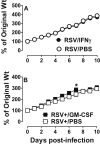Age predicts cytokine kinetics and innate immune cell activation following intranasal delivery of IFNγ and GM-CSF in a mouse model of RSV infection
- PMID: 28558308
- PMCID: PMC5541950
- DOI: 10.1016/j.cyto.2017.05.019
Age predicts cytokine kinetics and innate immune cell activation following intranasal delivery of IFNγ and GM-CSF in a mouse model of RSV infection
Abstract
Respiratory syncytial virus (RSV) is the leading cause of lower respiratory tract infections in young children and is further associated with increased healthcare utilization and cost of care in the first years of life. Severe RSV disease during infancy has also been linked to the later development of allergic asthma, yet there remains no licensed RSV vaccine or effective treatment. Pre-clinical and clinical studies have shown that disease severity and development of allergic asthma are associated with differences in cytokine production. As a result, stimulation of the innate host immune response with immune potentiators is gaining attention for their prospective application in populations with limited immune responses to antigenic stimuli or against pathogens for which vaccines do not exist. Specifically, macrophage-activating cytokines such as interferon gamma (IFNγ) and granulocyte colony-stimulating factor (GM-CSF) are commercially available immune potentiators used to prevent infections in patients with chronic granulomatous disease and febrile neutropenia, respectively. Moreover, an increasing number of reports describe the protective function of IFNγ and GM-CSF as vaccine adjuvants. Although a positive correlation between cytokine production and age has previously been reported, little is known about age-dependent cytokine metabolism or immune activating responses in infant compared to adult lungs. Here we use a non-compartmental pharmacokinetic model in naïve and RSV-infected infant and adult BALB/c mice to determine the effect of age on IFNγ and GM-CSF elimination and innate cell activation following intranasal delivery.
Keywords: Age-dependent; Cytokine kinetics; Granulocyte macrophage-colony stimulating factor; Infant; Interferon gamma; Respiratory syncytial virus.
Copyright © 2017 Elsevier Ltd. All rights reserved.
Figures









Similar articles
-
Alveolar macrophages support interferon gamma-mediated viral clearance in RSV-infected neonatal mice.Respir Res. 2015 Oct 5;16:122. doi: 10.1186/s12931-015-0282-7. Respir Res. 2015. PMID: 26438053 Free PMC article.
-
GM-CSF treatment prevents respiratory syncytial virus-induced pulmonary exacerbation responses in postallergic mice by stimulating alveolar macrophage maturation.J Allergy Clin Immunol. 2016 Mar;137(3):700-9.e9. doi: 10.1016/j.jaci.2015.09.031. Epub 2015 Nov 10. J Allergy Clin Immunol. 2016. PMID: 26560044
-
Data describing IFNγ-mediated viral clearance in an adult mouse model of respiratory syncytial virus (RSV).Data Brief. 2017 Jul 19;14:272-277. doi: 10.1016/j.dib.2017.07.034. eCollection 2017 Oct. Data Brief. 2017. PMID: 28861450 Free PMC article.
-
Immunopathology of RSV infection: prospects for developing vaccines without this complication.Rev Med Virol. 2007 Jan-Feb;17(1):5-34. doi: 10.1002/rmv.518. Rev Med Virol. 2007. PMID: 17004293 Review.
-
The pathogenesis of respiratory syncytial virus disease in childhood.Br Med Bull. 2002;61:13-28. doi: 10.1093/bmb/61.1.13. Br Med Bull. 2002. PMID: 11997296 Review.
Cited by
-
The Development of Classical Swine Fever Marker Vaccines in Recent Years.Vaccines (Basel). 2022 Apr 13;10(4):603. doi: 10.3390/vaccines10040603. Vaccines (Basel). 2022. PMID: 35455351 Free PMC article. Review.
-
Pulmonary Susceptibility of Neonates to Respiratory Syncytial Virus Infection: A Problem of Innate Immunity?J Immunol Res. 2017;2017:8734504. doi: 10.1155/2017/8734504. Epub 2017 Nov 9. J Immunol Res. 2017. PMID: 29250560 Free PMC article. Review.
-
Mucosal IFNλ1 mRNA-based immunomodulation effectively reduces SARS-CoV-2 induced mortality in mice.EMBO Rep. 2024 Sep;25(9):3777-3788. doi: 10.1038/s44319-024-00216-4. Epub 2024 Jul 26. EMBO Rep. 2024. PMID: 39060455 Free PMC article.
-
Comparison of Immune Checkpoint Inhibitors between Older and Younger Patients with Advanced or Metastatic Lung Cancer: A Systematic Review and Meta-Analysis.Biomed Res Int. 2019 May 13;2019:9853701. doi: 10.1155/2019/9853701. eCollection 2019. Biomed Res Int. 2019. PMID: 31214620 Free PMC article.
-
Alveolar macrophages and airway hyperresponsiveness associated with respiratory syncytial virus infection.Front Immunol. 2022 Oct 20;13:1012048. doi: 10.3389/fimmu.2022.1012048. eCollection 2022. Front Immunol. 2022. PMID: 36341376 Free PMC article. Review.
References
-
- R M. Hilleman, Vaccines in historic evolution and perspective: a narrative of vaccine discoveries. Vaccine. 2000;18(15):1436–47. - PubMed
MeSH terms
Substances
Grants and funding
LinkOut - more resources
Full Text Sources
Other Literature Sources
Medical
Research Materials

